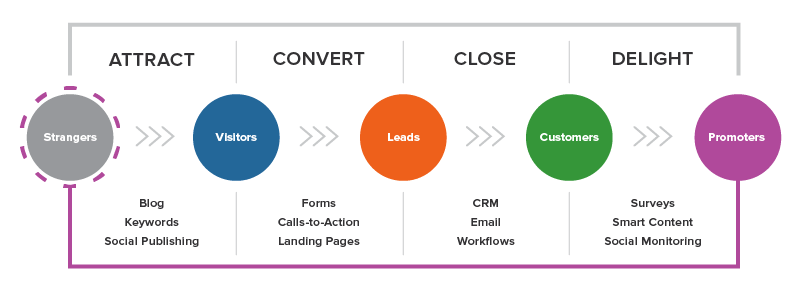HubSpot identifies lead generation as the process of attracting and converting strangers and prospects into someone who has shown interest in your company’s products or services.
According to how HubSpot handles lead generation, it falls within the second stage of the inbound marketing methodology.
It occurs after you’ve attracted an audience and are ready to convert those visitors into leads for your sales team (namely sales-qualified leads or SQL), which we’ll be tackling further in this article.
There are several methods and strategies of handling lead generation:
- Lead Qualifying
- Lead Conversion
- Inbound Marketing Methodology
- Lead Scoring
1Leads Qualifying
Leads are part of the broader cycle that consumers follow when they transition from visitor to customer.
But not all leads are created equal–they don’t have the same qualities.
Different types of leads are based on how they are qualified and what stage they’re in.
1. Marketing Qualified Lead (MQL)
Marketing qualified leads are contacts who have shown interest by viewing your page, your pricing, or other factors.
These types of leads are the ones who aren’t ready for a sale yet but are responsive to you.
2. Sales Qualified Lead (SQL)
These are contacts who have taken action and asked questions that show becoming a paying customer.
An example of an SQL is someone who reaches out to the company about their inquiries.
3. Product Qualified Lead (PQL)
These leads are people who have had experience using your product, therefore having a higher chance of being a customer.
You can acquire these leads if you offer a product trial or a free version of your product with options to upgrade, which is where your sales team comes in to push them into upgrading.
4. Service Qualified Lead
These are contacts or customers who have indicated to your service team that they’re interested in becoming a paying customer.
A typical example of a service qualified lead is a customer who tells their customer service representative that they’d like to upgrade their product subscription.
The customer service representative will then introduce the customer to the appropriate sales team or representative.
-
How to Qualify a Lead
Sales leads are basically generated through information collection.
The amount of information collected is then used as a basis to qualify a lead.
This information can be collected in different ways which can be used for qualifying leads.
-
Information Collection
Job Application:
In this scenario, an individual that fills out an application shows their interest in the job.
This can qualify the person as a lead for the company’s recruiting team.
Coupon:
Coupons are valuable sources of information.
People will be willing to provide their name and email address in exchange for a coupon. I know I will.
Although it’s not a lot of information, it’s enough for a business to know that someone has an interest in their company.
They included their email address, which is a way for a company to contact the customer or update them with promos, more coupons, subscriptions, or anything that may spark their interest.
Content:
When people apply for eBooks and webinars, they supply some basic information.
You can use these to determine their interests based on the content they sign up for.
You’ll need to collect enough information to gauge whether someone has a true, valid interest in your product or service.
How much information you get will depend on your strategy on how to acquire them.
You may try to imagine yourself as a customer and try to think of just what type of information you would be willing to give.
-
Information to Ask For in a Lead Generation Form
Full Name:
This is the most fundamental information needed to personalize your communication with each lead.
Email:
Email serves as a unique identifier in contacting your lead.
Company:
This will give you the ability to research your lead’s industry, company and how the lead will benefit from your product or service (mainly for B2B).
Role:
Knowing an individual’s role will help you understand how to approach them and relate to them.
Country:
Having the location information of a lead can help you group your contacts by region and time zone, and help you qualify the lead depending on geography.
State:
This helps in collecting detailed information about your lead’s location.
Knowing your lead’s state can help you group and qualify them further.
2Lead Conversion

(Image Source: Lead Squared)
Another important method of handling lead generation is lead conversion.
As a marketer, one of your goals should be to create a lead generation process and remove all of the distractions that commonly prevent visitors from converting.
The conversion process includes:
1. Shorten Your Lead-Capture Forms
You need to ask only for the information you need to contact and adequately qualify your leads, understand that there is a delicate balance between quantity and quality.
2. Create Targeted Landing Pages
If you’re promoting a landing page to a segment of your prospects that you’ve identified as interested in a particular topic or have a specific need, tailor the landing page to speak to those needs and address those topics.
3. Remove Top/Side/Bottom Navigation
If prospects make their way to your landing page, don’t you want to keep them there?
Streamline the conversion process by removing any other top/side/bottom website navigation from your landing pages.
Do these to keep visitors from feeling compelled to leave and visit another page on your site.
4. Get Rid of Other CTAs on Landing Pages
Don’t distract them from the offer you’re promoting by showcasing other conflicting calls-to-action. Keep your page focused on that offer, and focus your efforts on convincing visitors to convert there.
5. Create Clear and Optimized CTAs for Your Website/Blog
As a marketer, not only should you be creating landing pages for your offers, but you should be optimizing your website and blog for conversion, too.
6. Share Landing Page Links in Social Media
Inbound marketers understand that social media is an effective tool for lead generation. They must do all it takes so that social media users are converted into leads.
Rather than promoting an offer and sending social media fans/followers to your website’s homepage, direct them to a unique landing page for that offer.
7. Stick to One CTA in Email Marketing
Your email messages should be focusing on a particular offer.
Ensure that you focus your energy around communicating how valuable that one offer is rather than splitting your attention amongst two or more offers.
8. Put Landing Page Forms Above the Fold
Make sure your form is easily visible, and the visitor understands that to receive the offer you’re providing, filling out the form is essential.
Making your visitors scroll down is just another way to create friction.
9. Use Actionable Language
Make sure that visitors know exactly what to do by using actionable and definitive language in your CTAs, on your landing pages, and in your forms.
There should be no guessing involved in understanding how visitors can obtain your offer.
10. Make It Easy
Don’t make your visitors go through all sorts of baseless and unnecessary stress in order to obtain your offer.
Make the process as easy as possible.
3Inbound Marketing Methodology
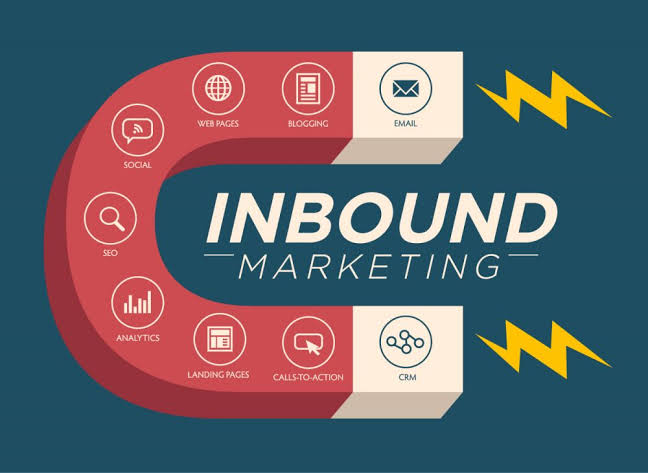
(Image Source: iSmart)
This methodology entails the following process:
– First, a visitor discovers your business through one of your marketing channels, such as your website, blog, or social media page.
– Then, the visitor clicks on your call-to-action (CTA), which could be either an image, button, or message that encourages website visitors to take action.
– The call-to-action takes your visitor to a landing page, which is a web page that is designed to capture lead information in exchange for an offer.
– On the landing page, your visitor fills out a form in exchange for the offer.
4Lead Scoring

It is a way to qualify leads quantitatively.
With this technique, leads are assigned a numerical value (or score) to determine where they fall on the scale from interested to ready for a sale.
The criteria for these actions must be uniform across your marketing and sales department so that everyone is working on the same scale.
The score for a lead is based on actions they’ve taken, the information they’ve provided, their level of engagement with your brand, or other criteria that your sales team determines.
You might assign a lead a higher score if they used one of your coupons as this is an action that signifies that this person is interested in your product.
The higher a lead’s score, the closer they are to being a sales-qualified lead (SQL), which is only a step away from becoming a customer.
Lead Generation Plan Template
There are two primary methods for developing a perfect strategy–the Funnel and the Flywheel.
The traditional, one-off funnel method focuses on attracting leads and nurturing them into sales.
While the flywheel approach uses inbound marketing and other strategies to build long-lasting customer relationships, the funnel strategy focuses on the awareness, consideration, and decision stages of the customer’s journey.
The circular flywheel focuses solely on attracting, engaging, and pleasing prospects, leads, and customers.
The moment a lead finally becomes a customer, the flywheel continues.
The company is tasked with attracting, engaging, and positively stimulating them all over again with premium customer experiences, new content, and potentially new offers.
To achieve these, your planning process should include these steps:
- Distinguish your buyer persona(s)
- Fill out your persona’s value matrix
- Define your content and lead-gen strategy
- Adjust and iterate as you go
- Retain and delight your customers
Below are basic fill-in-the-blank templates to help you get started .
Step 1: Distinguish Your Buyer Persona(s)
Try to do a bit of research and identify your buyer persona. You can have more than one but make sure each is concise, clear, and different from the others.
Step 2: Fill Out Your Persona’s Value Matrix
The table below includes each piece of the value matrix, as well as an example persona.
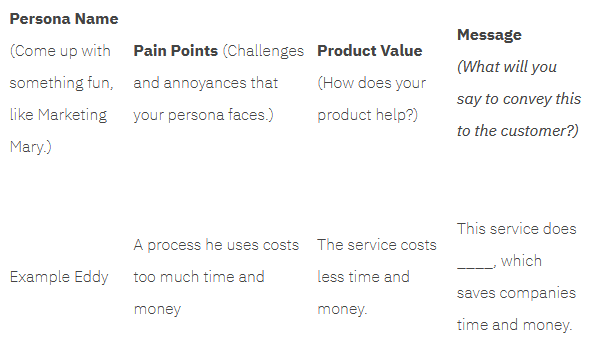
(Image Source: HubSpot)
Step 3: Define Your Content and Lead-Gen Strategy
Create content and lead-generation plan based on your customer’s journey.
Since some prefer flywheel and others prefer funnel, the template is split into Phases One, Two, and Three, with notes on where you should be in the flywheel and funnel’s cycles.
Phase One
Funnel Stage: Awareness
Flywheel Goal: Attract Prospects
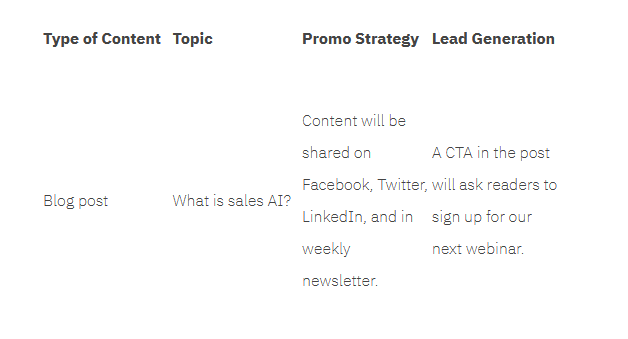
(Image Source: HubSpot)
Make a table like this one below to catch the eye of potential customers in similar industries.
Phase Two
Funnel Stage: Consideration
Flywheel Goals: Attract and Engage Leads
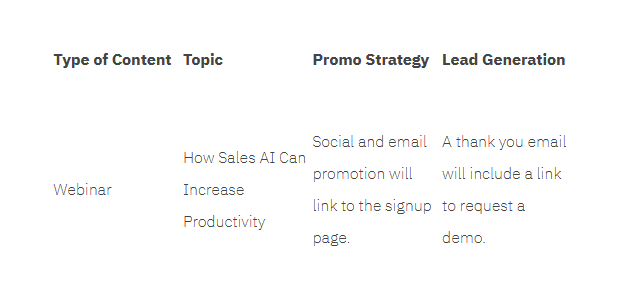
(Image Source: HubSpot)
In this phase, your audience might know of your services, or they might be researching products related to yours.
Phase Three
Funnel Stage: Decision
Flywheel Goals: Engage and Nurture Leads / Gain and Delight Customers
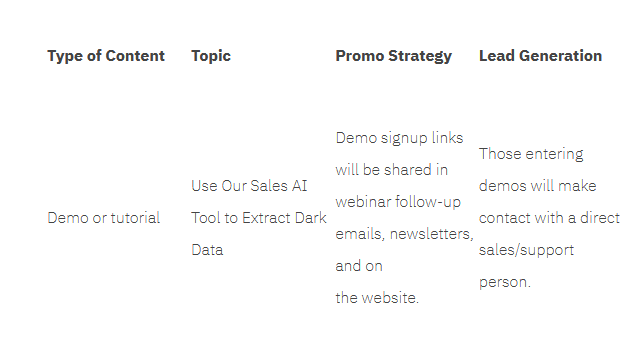
(Image Source: HubSpot)
Step 4: Adjust Upgrade As You Go
Go back to certain areas of your plan that aren’t working and improve them.
Pay attention to the things that are working, and brainstorm ways to expand on them.
Step 5: Retain and Delight Your Customers
Your goal and focus at this stage is to maintain your customer relationships and get referrals through word-of-mouth.
This is where a flywheel strategy can be much more helpful than the funnel, which ends at sales.
Lead Generation Model
Lead generation includes any, or a combination of, the following:
Broadcast Advertising
Broadcast advertising includes the use of radio advertising and infomercials. It also uses other aspects of broadcast media to advertise products of a company to stand out among competitors.
Online Lead Generation
Online lead generation includes pay-per-click models, search engine optimization activities, and video marketing. It also includes downloading free (or paid) information in exchange for lead info, responding to surveys, registering for online services, and webinars.
Direct Mail
Generating leads through direct mail still works today.
Becoming effective at direct mail lead generation can make or break a lead-generating marketer since the costs demand critical attention to testing, comparison and refinement.
Event or Trade Show Marketing
It is a traditional form of formal and informal lead generation.
The formal aspect of this is presented by the ways exhibitors desire to engage attendees at these expos.
The informal aspect of trade shows is presented by the nature of many professionals who attend such conferences.
It is to establish new business leads through personal networking.
Seminars or Training
Provide seminars and training sessions for popular subjects, such as health, finance, insurance, software, marketing, etc.
Although the seminars may be low-cost or even free, it is an important revenue stream to generate leads.
Publicity and Public Relations
Some businesses adopt online press release services as a primary driver of new leads.
Whitepapers or Product Literature
Requesting free information from a company is a classic lead generation strategy that has been prominent and is one of the oldest methods on this list that is used in the online world.
Email Marketing
Lead generation using email is still effective, and it is among the lower cost channels to identify and convert leads into sales.
Email marketing is a subset of internet marketing whereby prospects are offered something valuable in exchange for their email address.
It is so that you can follow-up with them about their interests and also inform them about your products and services.
Telemarketing
Telemarketing can be conducted in residential lines for political organizations, charities, surveys, and existing business relationships.
Social Media
Lead generation through social media channels such as YouTube, Facebook, LinkedIn, etc., command such a large amount of Internet traffic.
They have become a force independent of search engines and offer their own paid advertising opportunities.
Lead Generation for Enterprise Sales
Some large companies can research and submit a form on your site.
But some never even bother doing research and outsource it to consulting firms.
At an enterprise level, companies need to target large organizations by implementing account-based marketing (ABM) strategies.
The strategies are:
Qualify the Leads that Come Through Traditional Digital Marketing Channels
Every marketer must bring in the leads to rank and qualify them.
You must post the revenue of each lead to the company CRM to notify the sales team immediately when the large company submit a contact form or download your digital content.
Account-Based Marketing
With account-based marketing (ABM), marketers can create a list of companies to target.
They can track how they interact with the digital content and get predictive analytics such as buying intent.
They can even deliver the ads through IPs and third-party cookie databases to the top executives and decision-makers.
Use Predictive Analytics Strategy
Using marketing predictive analytics tools like Bombora or 6sense can help to uncover decision-making patterns, buying intend data, and information on the prospects.
PPC Advertising Targeting by the Industry, Company, and Job Title
Reaching enterprise-level companies and executives through programmatic advertising.
Fulfilling them by using demand-side platforms (DSP’s) such as LinkedIn and PPC networks that offer job title and company targeting options.
Identify Who is Visiting Your Website
The use of technology helps marketers to identify by IP what companies are visiting their sites.
This turns the silent visitors into ‘early stage’ and ‘top-of-the-funnel’ leads.
Find Lead Resellers Who Can Offer Enterprise Opportunities
Some large companies and top executives don’t bother searching for new technology by themselves.
Instead, when it comes to choosing the right B2B/SaaS product or technology, they rely on consulting firms, industry influencers, and advisers.
Technology Evaluation and Review Networks
Technology evaluation and software review networks can put your company on the RFP ‘shortlist’ when large companies are looking for products.
Targeting Clients of Your Competitors Can Open New Big Opportunities
It is much easier to put a better offer than chase the companies that might never buy from you.
Targeting Top Consulting Companies
By targeting top consulting experts that focus on your industry, you get on their radar and put your product in front of their clients.
Key Takeaway
HubSpot handles Lead generation using several methods and strategies that have been proven effective. Put all this together, it positions HubSpot as one of the most effective models to follow in lead generation.
Want to help contribute to future articles? Have data-backed and tactical advice to share? I’d love to hear from you!
We have over 60,000 monthly readers that would love to see it! Contact us and let's discuss your ideas!
